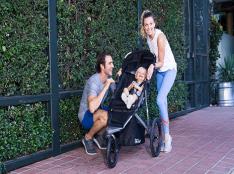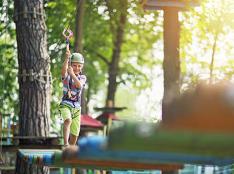
If you think back to your earliest childhood memories, some of the highlights probably involve riding a bike around your neighborhood.
It's the driver's license before actually having a driver's license, where the freedom of the open road (or sidewalks for younger riders) meant long days exercising in the sunshine and fresh air with family and friends.
Us big kids now have kids of our own, and despite all of life's peaks and valleys, we never stopped riding—and passing down our hobbies and passions to the next generation is one of life's great pleasures.
But what's the best, and safest, way to bring your little one along for one of your bike rides?
There are endless options to do so, but we listed some of the easiest, safest, and most fun tools to get started for all ages. No matter which you choose, always remember, safety first—this means helmets worn by anyone at all times. Click here for a complete list of bicycle safety tips for kids.
Looking for bike-related gear for your little one? Head over to ACTIVE GearUp for steep discounts on top active brands.
Ages 1 to 5
With tons of intuitive and safe products on the market, you can literally start riding your bike with your little one as soon as you think they're ready. The first step is to find a bike trailer that attaches either to your back hub or your seat post that's pulled behind your bike. These two-wheeled buggies come in various sizes, but all have a mesh zippered flap that can be closed for safety (if you have a wiggly escape artist) and sun protection or left open to let more light and fresh air in. Either way, there's also a system that will buckle your child in place, and storage areas for sunscreen, snacks, hats, and water.
Once your little one has the strength and coordination to sit up and look around, a bike seat is the next most common option. They're similar to a car seat where it's a plastic shell with padding and a harness, and these infant bike seats usually attach behind your saddle or on your handlebars. These kid bike seats put them in a riding position that's closer to you and give them a brand new vantage point not experienced in a bike trailer.
Ages 3 to 5
A trailer bike can be considered the next step in this progression, as it's a single-wheeled system that attaches to your seat post. It has its own handlebars and pedals (some trailer bikes have shifters), so they'll get the feel of riding without being required to do any of the balancing themselves. They can even contribute to the workload, as their pedaling helps both them and you move forward.
The real stars of the show are push bikes. You've probably seen these used by kids around your neighborhood, but they're miniature bikes without pedals that allow your little ones to push their feet against the ground to propel themselves forward. This ultimately makes for a seamless transition to riding a "big kid" bike, as the balance and handling are exactly the same. Push bikes come in a range of fun colors, shapes, and sizes, and some even have a conversion kit to add pedals when your little one is ready.
Ages 4 to 7
Of course, all kids progress differently, but this is around the time when most start riding a bike with pedals. If they've practiced on a push bike before this step, they'll likely have no trouble adjusting to the pedaling motion, but if not, training wheels might be necessary. Head to your local bike shop to see what size bike they recommend, and don't worry about buying the most expensive bike with all the bells and whistles—your little one will outgrow their first real bike before you know it. Another option is to look on Craigslist or Facebook Marketplace to buy a used "first bike" to save some money.
Ages 8-plus
By this point your little one is growing fast and has likely already been joining you on rides around the neighborhood. It's time to invest in a larger, stouter bike that can grow with them and take the wear and tear of harder riding. A basic BMX-style bike is a great option, but if your little one is expressing interest in longer rides, consider a bike with a handful of gears to make riding up and down hilly streets easier. As we mentioned before, your local bike shop can point you in the right direction and will be a valuable resource if your kid's bike needs tune-ups and parts replaced.
READ THIS NEXT: Bicycle Safety Tips for Kids









Discuss This Article